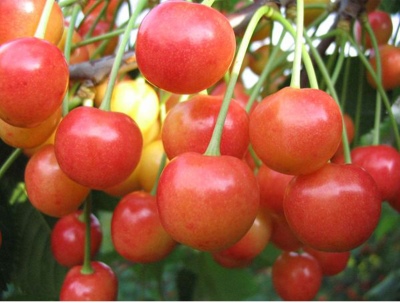
- Pruning: Yes
- Fruit shape: rounded, with a rounded top, with a depression at the base
- Authors: T.V. Morozov, All-Russian Research Institute of Horticulture. I.V. Michurina
- Growth type: medium-sized
- Appointment: universal
- Tree height, m: 4
- Crown: rounded oval, raised
- Escapes: thick, straight, naked, gray-green, with a few small lentils
- Sheet: large, narrow oval shape, double-serrated serration, smooth relief, dark green, shiny, without pubescence
- Fruit size: above medium or large
Pink pearls are very popular with gardeners and are considered to be the orange variety. It is distinguished for its resistance to adverse weather conditions, diseases and pests. Berries are suitable for fresh consumption, for freezing, making jam, compote, jam, jelly.
Breeding history
The domestic variety was bred at the V.I. I.V. Michurin, breeder T.V. Morozova. The culture was obtained from the seed of the Leningradskaya yellow cherry, treated with the chemical mutagen HMM.
Description of the variety
The tree is medium-sized, reaches a height of 4-5 m, its crown is rounded or oval, raised. The bark on the trunk and skeletal branches is brown, prone to peeling. The branches are thick, straight, gray-green in color. The leaves are large, narrow, oval, smooth, shiny, dark green. The flowers are large, white, collected in inflorescences of 3-5 pcs. Sweet cherry blossoms in mid-May, flowering can last until early June. Differs in a high growth rate of shoots. The life of the plant is about 15 years.
Fruit characteristics
The berries are medium or slightly larger, weighing 5.5-6.5 g, rounded, orange-pink in color. The pulp is of medium density, tender and juicy. The stone is medium in size, well separated. The appearance of the berries is very attractive, but their transportability is rated below average. It is not recommended to transport for long distances.
Taste qualities
The taste is sweet, with a slight sourness. Tasting score - 4.8 points.
Ripening and fruiting
The tree begins to bear fruit in 5-6 years, it belongs to the mid-ripening in terms of ripening - the harvest ripens in the first half of July.

Yield
Assessed as high and regular: about 13-18 kg are removed from one tree.
Growing regions
The variety is suitable for planting in the Central Black Earth and Lower Volga regions.
Self-fertility and the need for pollinators
Self-infertile species: additional pollinators are required to obtain a harvest, such as Michurinka, Michurinskaya late, Adelina, Ovstuzhenka, Poetziya, Rechitsa. Pink pearls themselves can act as a pollinator for other varieties.
Growing and care
The culture is considered easy to care for and unpretentious to grow. The tree prefers well-lit areas, does not tolerate wetlands and the proximity of groundwater. The seedlings are placed on a small elevation, and a drainage layer must be poured into the planting pit. Young plants are planted in the same way as other types of cherries.A distance of 2 m is left between the plants, 3 m between the rows.
Watering is recommended in moderation: watering Pink pearls only during the complete absence of rain. In this case, 5-6 buckets of water are poured under one adult tree, and 2-3 buckets are enough for a young one. Every year it is imperative to fertilize, about 2-3 times per season.
They are fed in early spring with nitrogen fertilizers, then during the ripening of the crop with potassium and phosphorus. In the second year after planting in March, 120 g of urea is added dropwise to a depth of 10 cm in the near-trunk circle, then watered. In the 4th year, 400 g is added to the trunk, and in August granular superphosphate is added - 350 g. In the fall, I mulch the root area around the trunk with humus and straw.
Pink pearls are pruned regularly in the early years to thin out the dense crown and stimulate yields. Branches growing vertically must be removed, they should not be more than a quarter of the total mass of the crown. In autumn, it is recommended to whitewash the stem to protect the bark in winter and early spring from sunburn.




Disease and pest resistance
The culture has a high resistance to fungal diseases, primarily to coccomycosis and moniliosis. Of insects, aphids are often affected, from which treatment with the drug "Oxyhom" helps - dissolve 20 g of the agent in 6 liters of water and spray it. The interval between treatments is about 10 days. Other pests rarely attack.

Requirements for soil and climatic conditions
This cherry grows well in temperate and warm climates, tolerates temperature changes well, and is especially resistant to sudden cold snaps. It perfectly tolerates spring frosts. Winter-hardy species: withstands frosts down to -27 degrees. Flower buds do not freeze even in severe winters.
This is a drought-resistant variety: prolonged drought and severe overheating have practically no effect on the quality of the crop. The plant prefers nutritious light loamy or sandy loamy soil with a neutral reaction.

Review overview
According to gardeners, it is a trustworthy variety that has good winter hardiness. Very beautiful berries on the branches attract the attention of everyone who comes to the garden in summer, and they taste very sweet and fragrant. Berries appear every year, regardless of the vagaries of the weather.































































